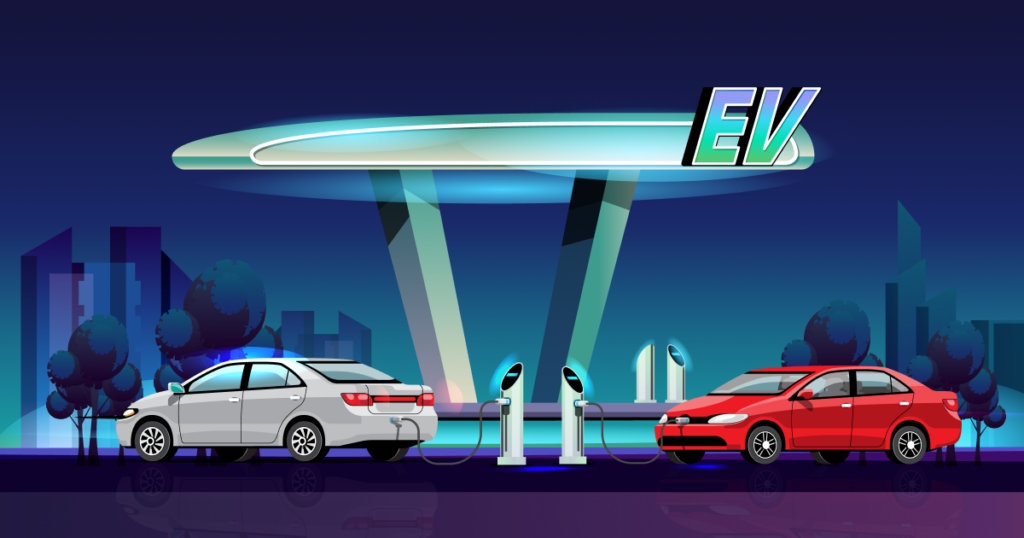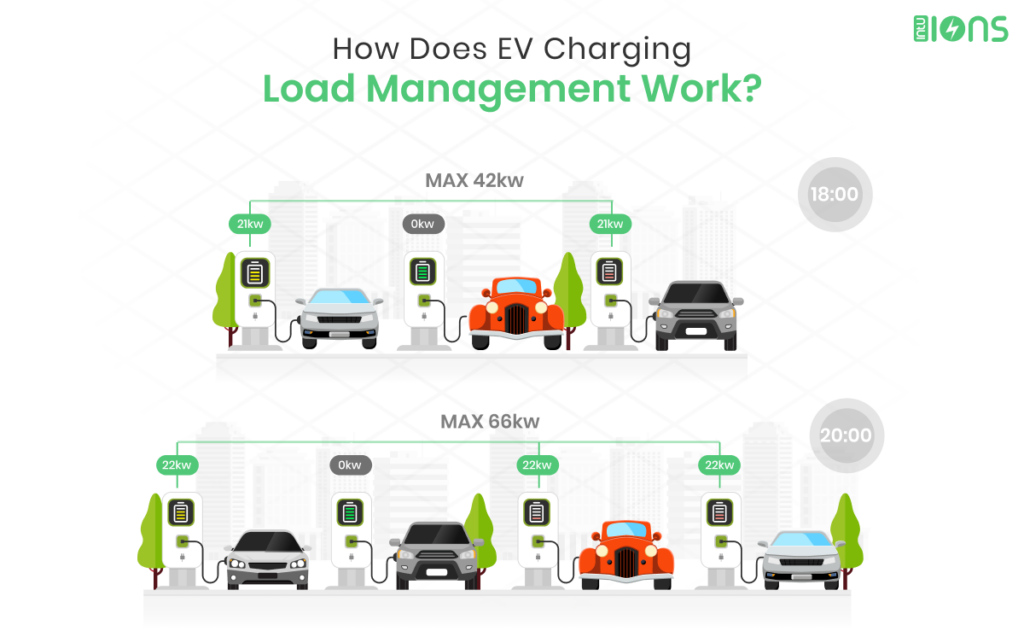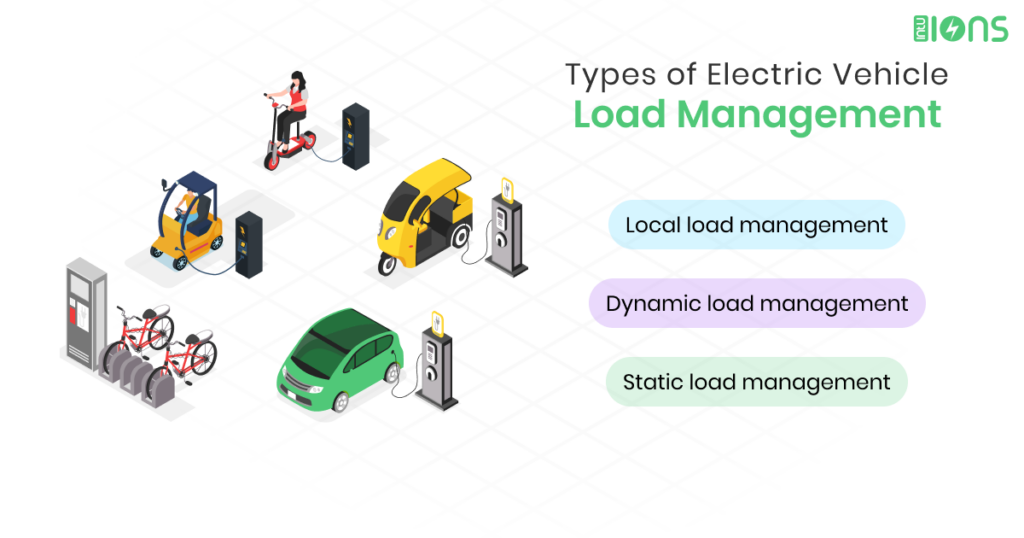How EV Charging Load Management Works

EV load management balances energy consumption and saves money for EV owners and electrical grid managers. But how does EV charging load management work? What are the types of EV load management and balancing? How does EV charging reduce the load using grids? Let us get all the answers in this new blog post:
There is growing pressure on the Electric Vehicle (EV) charging infrastructure due to the increase in the number of EVs hitting the road. More EVs obviously mean a greater need for chargers. For the same reason, charging load management is a hot topic right now.
Today, you will find many commercial and multi-residential buildings deploying charging points in abundance. But it is not hunky dory. They have to face many challenges, such as power capacity and limited grid connection. Load management provides a solution for these issues.
So, what exactly is EV charging load management?
EV charge load management enables you to use your building’s existing electrical panel power capacity to charge multiple EVs through charging stations. This allows the stations to communicate with each other, maintaining a steady electrical current throughout.
Maintaining load and cutting back on energy consumption during peak periods is necessary. EV charging load management moves the charging session to a time when energy is more affordable or readily available – if you take a microscopic view.
EV charging load balancing optimizes Electric Vehicle charging while easing the strain on the grid, which is already under pressure from conventional peak demand. The load impact is felt on the power grid when multiple charging points are operated on a micro level.
In situations with numerous charging stations in operation, this system distributes the energy levels evenly so that vehicles can be charged in a manner that best meets the needs of the user and their vehicle.
On a larger scale, EV charging load management establishes a balance between the power demands at various locations, including individual charging stations, fleet depots, multiple-household units, public parking lots, and so on. Load management streamlines EV charging without compromising electricity supply to households or businesses.
Customers can manage their load to control how much electricity is used to charge EVs. If the charging system requests more power than the grid can provide, the system controller, with load management enabled, will recalculate and change the availability at each charging station in the system.
Let us say your electrical panel has an 80 amp capacity, but you have four chargers that each requires 40 amps to charge fully. Each charging station would use more electricity than the electrical panel could supply if they all operated at total capacity at once, creating problems and overloading the electrical panel.
But power can be shared among all four charging stations if the chargers can interact with one another. They will only make an effort to impose electricity that is feasible.
How does EV charging load management work?
If you are looking to deploy multiple charging stations for your Electric Vehicles, you may have come across the term “Local Load Management” or LLM. While single-occupant homes can leverage EV load management systems, commercial and multi-unit dwellings should go for load-sharing EV chargers with multiple charging stations.

Managing the energy flow between charge points and on-site storage systems, EV charging load balancing gives instructions to the chargers on how much energy to deliver. It balances out peak demand at charging sites, on campuses, and if there is any on-site battery storage. It must control the volume and power requirements of EVs entering the site, which is crucial in an EV fleet environment.
Different load management techniques are used for the same. The ability to regulate when power is utilized, where it goes, and how much goes to each vehicle, all with a minimum of human effort, is what most people concentrate on. A user will often be able to prioritize specific components.
For instance, based on cost, you can set a maximum consumption limit and tell the system to charge your three vehicles independently during the night. This enables you to charge every vehicle as much as possible without endangering the electric system or running the risk of hefty demand fees.
Some can even be configured to use more power when there is a gap between supply and demand on the grid, allowing consumers to take advantage of that situation while helping the power system.
Additionally, these devices are elementary to operate. You can choose to have the system measure peak power or energy usage based on the overall consumption, the amount utilized over a certain period, or the amount responsive to grid demand.
Then you choose power-sharing parameters, allocating specific amounts to each car or employing a first-in, first-out scheme. A software-based, hardware-independent solution that continuously communicates with the station’s power infrastructure and the car charge points is used to enable EV charging load control. EV charging load balancing can be either:
- Static where it is, for example, “preassigned” based on the time of day. Static load balancing adjusts available power between EV chargers based on fixed allocated supply capacity within the charging hub. It distributes the traffic without taking into account the systems’ present condition.
- Dynamic, where it varies in real-time while utilizing sophisticated algorithms that modify energy use and direct it to the most crucial locations. Dynamic load management algorithms consider the present state of the system and distribute the traffic accordingly.
The charging systems communicate with the EV charging management software in real-time and report the preferences and demand accordingly. This method allows numerous EV charging points to operate simultaneously as it offers the highest potential charging power without compromising the power supply and electrical grid.
EV charging load balancing can be determined in advance based on variations in peak demand. For example, an EV fleet may want to respond to real-time changes like vehicles arriving or leaving around the day.
Types of Electric Vehicle load management
Twenty e-cars charging at maximum speed concurrently would result in astronomical power consumption. Thus, it is clear that the charging infrastructure of a building with numerous wall boxes needs to be closely monitored.

A control unit decides how much electricity can be delivered for charging to prevent overloading the building’s electrical system. Load management and balancing refers to the allocation of consumers between vehicles and buildings. It can be done through one of the following ways:
1. Local load management
Local load management, commonly referred to as demand-side management (DSM), is the act of controlling or altering the load rather than increasing the power plant’s production to control the grid’s electricity consumption.
While reducing the quantity of power utilized by utilities, businesses, and consumers, the focus should be on regulating the demand for output rather than the output itself. With the rise in EV usage, local load management has become more crucial.
Reports estimate there will be far more Electric Vehicles on the road than the current 16.5 million. The predicted figures are over 300 million EVs on the road by 2030. There have been innovations in how to alert drivers about the ideal charging times and the potential grid overloads.
Smart charging apps produce a schedule of the ideal times to charge using information like the electrical grid’s condition, the energy consumption of the area and each EV, and the mobility requirements of each driver (how far they are from the station).
It keeps Electric Vehicles “grid-friendly,” which means there are never more EVs charging at once than the system can support.
2. Dynamic load management
A function known as dynamic load balancing continuously tracks variations in the amount of energy used on your circuit and automatically distributes the available capacity to various appliances. According to variations in the electrical load, it balances the energy utilized and modifies the charging output of your EV.
Dynamic load balancing might decide, for instance, to slow down or stop the car’s charging process if a washing, dryer, and car are all connected simultaneously to make room for the other devices. The charger resumes or speeds up the EV’s charging once they are turned off.
This also holds if you have several Electric Vehicles that you charge using the same electrical circuit. In that instance, dynamic load balancing automatically splits the energy between the two cars or gives one of the priorities of the car based on your preferences.
In the second case, dynamic load balancing will route more electricity to one of the automobiles while reducing or suspending charging for the other until more energy is available.
Dynamic load balancing is not a feature that all smart charging stations have, but many of them can be improved later because they can connect to the internet. Given the advantages of dynamic load balancing for maximizing electricity use in your house, it is a feature worth considering while looking for a charging station.
3. Static load management
Static and dynamic load management are distinguishable. The charging stations are merely given a set upper limit in static load management. No matter how many automobiles are plugged in, they would not receive a charge beyond the specified limit. All plugged-in cars share the maximum power equally. It ensures the home connection is always manageable and never at maximum capacity.
How EV charging reduces the load using grids
Although the rise of EVs and the charging infrastructure that goes with them benefits the environment and nations’ economies, the power grid may suffer. Before looking at potential treatments or strategies to alleviate them, it is crucial to understand the impact. For instance, the high charging loads associated with fast charging stations lead to:
- Unstable voltage
- Reliability issues
- Increase in peak demand
- Decreased reserve margins
To avoid future malfunctions and lessen the influence on the grid’s performance metrics, distribution firms should significantly consider installing rapid charging stations on sturdy buses, as the number of charging stations is increasing. A system upgrade is necessary if you want to exceed the advised numbers.
Utility companies must assess the power of buses and permit the installation of chargers following that information. It has been discovered that distributing fast charging stations among several buses is preferable to putting several charging stations on a single bus. Installing a fast charger on a weak bus results in high revenue losses.
Residential or commercial consumers use direct low-voltage power, and this low-voltage side is the most exposed. There are fast charging options, which place fast charging stations on the medium voltage side of the grid, which can support more load than the low voltage side.
Why you need EV charging load management
The last thing you want if your property has multiple Electric Vehicle charging points is to become inoperable due to system overload. With load balancing, you can eliminate the risk and be confident that everyone may charge their vehicles simultaneously without experiencing any problems.
Charging EVs place a significant demand on the nation’s power infrastructure, particularly at the busiest hours of the day. For instance, as everyone utilizes Sunday nights to charge their EVs for the coming week, a rise in power demand can be noticed.
This sudden surge in demand may harm the national grid. Electric Vehicles can regulate their demand on the system to prevent adding to the national grid’s load during peak hours.
Additionally, consistent charging gives you the best chance to reduce electricity costs. You can charge during off-peak hours when electricity providers frequently charge less for each unit of electricity consumed.
Additionally, it implies that your car receives a steady charge instead of one that repeatedly surges and drops off swiftly. Following is a list of the advantages of load management for residential and commercial properties:
- Reducing the chance of overload
- Lowering the cost of the electricity bill
- Safeguarding the building’s electrical infrastructure
- Reducing the cost of updating the infrastructure for electricity
- Ensuring optimum use of IoT in EV chargers despite the lack of available power
Overcoming Electric Vehicle charging challenges
Effective load management can be implemented using a variety of techniques. There are certain restrictions, though, some of which include:
1. Scalability
One of the biggest problems the EV charging sector faces is scalability. For the EV charging infrastructure to keep up with the exponential market development and handle a variety of charging use cases, the Electric Vehicle Service Provider (EVSP) must be able to expand their networks, widen their product lines, and provide drivers with a seamless charging experience. This will necessitate a backend technology that can improve charger availability by remotely diagnosing and resolving issues.
2. Charger uptime
The worst driver experience starts when they approach a broken charger. Of course, repairing a physically broken charger involves a site visit. However, software-related issues might also cause chargers to malfunction.
In that situation, EVSPs can offer a better driving experience thanks to a backend system that can interact with chargers, identify issues in real time, and enable remote operations to fix the charger. A system that can “repair” and automate these processes would be even better.
3. Multiple platform implementation options
Operators may encounter various difficulties when selecting an EV charging platform, including resource constraints in their IT operations, the requirement to support chargers from numerous vendors, the integration of networks from acquired enterprises, and demands for a quick time to market.
The solution can be found in a platform that offers various implementation options, enabling you to “purchase some, develop some, and expand as you grow,” following your demands. Grid operators will inevitably have to contend with site-level constraints given the exponential growth of EVs and their power needs for charging.
The immense difficulty is figuring out how to flatten the demand curve, increase consumption during off-peak hours, and reduce the peak load that utilities must support. If the backend system enables smart EV charging and intelligent energy management, EVSPs can benefit from utility incentives.
Over to you
EV charging load control capabilities help connect numerous charging stations to a single feeder while managing load and saving money. It allows you to configure your chargers to deliver a specified quantity of electricity during peak and off-peak hours with electricity load management.
Systems for managing the load of Electric Vehicles give you more control over when and how the charging stations are utilized to maximize savings.
In general, your EVSP must be able to control when electricity is used, where it goes, and how much goes to each vehicle – with minimum hassle. There is a need to prioritize cost and instruct the system to charge with a maximum energy consumption limit.
At the end of the day, you must ensure every vehicle is charged as much as possible without risking high-demand charges or threatening the electric grid.
If you want to get an IoT solution built to manage EV charging load management and energy consumption from the backend, you have come to the right place. We at IntuThings have immense experience building robust IoT in the Electric Vehicle market. If you want to discuss your project in detail, please book a free consultation with us.
